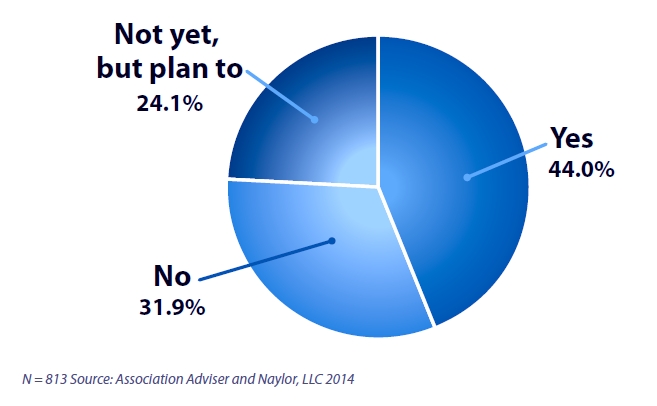What Associations Still Don’t Get About Technology

I once worked for a very large association that was continually reinventing itself. My former boss, who had an uncanny ability to get credit for our successes and dodge blame for our (many) failures, had a favorite saying, “The pioneers get the arrows and the settlers get the land.” In the never-ending race to stay current with members, experts tell us associations actually may be trying too hard to stay ahead of the technology curve. In other words, take the land, not the arrows in the chest.
“I’ve always felt you should stay slightly behind the curve, but ahead of the masses,” said Marcus Underwood, Naylor LLC’s vice president of online solutions. “If you are ahead of the curve, most of your members will not be there with you, and the costs of technology are higher ahead of the curve. Be in the first wave behind the ‘trailblazers.’ They have taken the briars and thickets and cleared the way for you.”
|
Renato Sogueco, CIO of the Society of American Florists (SAF) and chair of the ASAE Technology Council, agreed. “You need to venture out into the for-profit world regularly to see what’s coming next on the technology front. You don’t need to be on the ‘bleeding edge,’ but there’s no excuse for getting swept up unexpectedly in the next wave.” This approach also may help you keep your costs down when it’s time to pull the trigger, he said.
Diana Didia, CIO of the American Arbitration Association (AAA) agreed you don’t need to be on the bleeding edge, but you need to stay aware. If nothing else, make sure your staff is using current collaboration tools—something as simple is scheduling appointments automatically via Outlook. Make sure your staff at least has the same tech tools, resources and speed that they using at home. You want to avoid a situation in which your staff has more tech horsepower at home than they do at work. That can be very demotivating, she said.
Think strategy not cost center
According to Underwood, associations too often view technology as a cost center rather than a strategy. They need to be “less reactionary and more realistic” about the staffing resources needed to take advantage of their technology investments.
Sogueco said associations often view technology as a Whack-a-Mole game for every new security, connectivity or data challenge that comes up. That’s not a strategy. Technology should be a strategic initiative, starting at the board level, that helps your organization function more effectively at all levels.
Didia agreed. In addition to being CIO, she’s a senior vice president, which means she has a “seat at the executive table” and can influence many organization-wide business and strategic decisions—not just technology ones.
Investing in your member database
Member databases are the lifeblood of most associations, but many readers tell us theirs is outdated, ignored and often underutilized. Case in point: Nearly 30 percent of leaders who responded to last month’s Association Adviser reader poll said that changing or upgrading their member database would have the “single greatest impact” on their organization.
That’s not surprising, according to Fara Francis, CIO of the Associated General Contractors of America (AGC). “The challenges that many associations face are membership data manipulation, data integrity, data warehousing and data reporting,” she said. “Evidence of these issues revolves around the age of the database application, the out-of-date features and lacking functionality.”
SAF’s Sogueco said associations are increasingly learning to look at their members’ psychographics and online behavior patterns—not just their demographics and company contact information. “What does their LinkedIn and Facebook profile tell you about them? You need that personal connection to members if you want to stay relevant,” he said.
Importance of video
Nearly three in five respondents to a recent Association Adviser reader poll (59.1 percent) said they were currently using online video to connect with members or planning to do so this year.
Is your association using online video to enhance communication and education?

According to SAF’s Sogueco, “there’s a world of content out there that’s just waiting to be videotaped.” He predicts that by 2013, video will account for 90 percent of what’s shared on the web. “You have to ask yourself, ‘How do we retool and make it valuable to members?’” In fact, 17 percent of associations who responded to our recent reader poll said upgrading their video capabilities would have “the single greatest impact on their organization.”
| For more on the staggering growth of online video, see Charles Popper’s report in today’s episode of Association Adviser TV |
Tech mistakes and missed opportunities
“Associations often look at only the hard costs related to a technology and typically overlook the ongoing resources needed to use it effectively,” said Underwood. “One of the most common things we find is associations have invested (sometimes significantly) in technology and are underutilizing it because of all the staff time needed to use it correctly,” he said. “You must think beyond the sales-pitch and talk to other associations that have used the same technology. They will give you a better view of the ‘real’ costs of installing something new, and what pitfalls to avoid.”
AGC’s Francis agreed. “Associations often fail to consider the impact that new technology tools will have on the organization’s overall infrastructure. Too many associations are operating without an IT strategic plan.”
Build or buy?
In most cases, outsourcing will provide you with a better product over the long haul because the outsourced vendor will dedicate the resources to continuous improvement of the product functionality, said Underwood. In-house solutions can be cheaper and more customized, but they tend to age and become a drain on resources over time. According to Francis, if you’re going the in-house route, you need to assess if you can really build it fast enough, test it and implement it to meet the project deadline? “If the decision is to outsource instead, do strict due diligence on the outsource partner’s reputation.”
Closing the technology generation gap
“You can’t interact with your 25-year-old members the way you interact with your 50-year-olds, noted Dan Seligson a search engine and website optimization expert from Norwalk, Conn. “Each form of engagement has to be customized.”
AGC’s Francis said your annual events are a great venue for introducing simple technology applications to older members and other tech-shy members. Like AGC, SAF also uses its conferences to introduce less tech-savvy members to its new tools and applications.
Which social media platform is best for associations?
If you only have time to put effort into one, then Naylor’s Underwood recommended Twitter. “It’s great at driving awareness, general communication and promotion. It can be automatically integrated into your Facebook page, making the content there fresher,” he said.
AGC’s Francis suggested beginning with Facebook. “It’s easy to use, very popular and allows for member participation and member contribution.” Also remember that “digital natives” jump around a lot on their devices. “It’s imperative that information on all your Web-related platforms is current. You should also provide social vehicles for these individuals to connect and share,” she added.
According to Sogueco, you have to do your research first. Find out where your members and customers are. “In our case, it’s Facebook. We do engage with our members on our fan page, but it’s mainly for non-members to get to know us in a comfortable, non-threatening way.”
AAA’s Didia pointed to LinkedIn, particularly to LinkedIn groups. “Our new marketing director has been educating our sales reps about relevant discussion groups they can follow about arbitration topics. It’s a great way to stay current on what’s going on, find the industry influencers and look for leads,” Didia said. The AAA is also gaining traction with its white box social media solution.
Conclusion
With limited staffing and resources, associations need to be sure they’re investing in what their members really want, said Underwood. “That’s why it is so important to survey your audience and measure the response to your online initiatives.”
Sogueco said one of the best ways to get rapid adoption with a new tech initiative is to make it “a play activity, not a work activity.” Encourage your early-adopter members and staff to help your less tech-savvy members and staff get up to speed one app at a time. “We tell them: ‘Surprise your kids and grandkids about what you know how to do online,’” he said.
If only we had that philosophy back at the AAFNO (American Association of From Now On) each time a new technology initiative was pushed down on us from above. We could have spent more time settling into productive work and less time dodging arrows.
Hank Berkowitz is the moderator-in-chief of Association Adviser.

